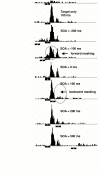Visual masking: past accomplishments, present status, future developments
- PMID: 20517494
- PMCID: PMC2864971
- DOI: 10.2478/v10053-008-0010-7
Visual masking: past accomplishments, present status, future developments
Abstract
Visual masking, throughout its history, has been used as an investigative tool in exploring the temporal dynamics of visual perception, beginning with retinal processes and ending in cortical processes concerned with the conscious registration of stimuli. However, visual masking also has been a phenomenon deemed worthy of study in its own right. Most of the recent uses of visual masking have focused on the study of central processes, particularly those involved in feature, object and scene representations, in attentional control mechanisms, and in phenomenal awareness. In recent years our understanding of the phenomenon and cortical mechanisms of visual masking also has benefited from several brain imaging techniques and from a number of sophisticated and neurophysiologically plausible neural network models. Key issues and problems are discussed with the aim of guiding future empirical and theoretical research.
Keywords: masking; neural networks; nonconscious/conscious processing; object perception.
Figures









References
-
- Alpern M. Metacontrast. J. Opt. Soc. Am. 1953;43:648–657. - PubMed
-
- Andreassi J.L., De Simone J.J., Mellers B.W. Amplitude changes in the visual evoked potential with backward masking. Electroencephalogr. Clin. Neurophysiol. 1975;41:387–398. - PubMed
-
- Averbach E., Coriell A. S. Short-term memory in vision. Bell. Syst. Tech. J. 1961;40:309–328.
-
- Bachmann T. The process of perceptual retouch: Nonspecific afferent activation dynamics in explaining visual masking. Percept. & Psychophys. 1984;35:69–84. - PubMed
-
- Bachmann T. Psychophysiology of visual masking: The fine structure of conscious experience. Commack, NY: Nova Science Publishers; 1994.
LinkOut - more resources
Full Text Sources
Other Literature Sources
Miscellaneous
